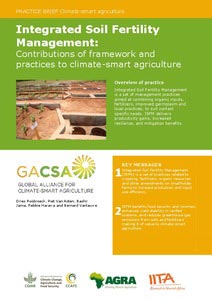Special feature: IITA long-term trials validate ISFM benefits

Integrated Soil Fertility Management: Contributions
of framework and practices to climate-smart agriculture
IITA researchers working together with other scientists have shown that food security, crop yields and farmers’ livelihoods; the resilience of cropping systems to climatic change impacts; and mitigation of greenhouse gas (GHG) emissions derived from fertilizer or soil are significantly enhanced when Integrated Soil Fertility Management (ISFM) is practiced during production.
To achieve these, stakeholders in agriculture advocate a shift in agro-practices to production systems that are “climate smart”. This means systems that are more productive, use inputs more efficiently, and are more responsive to local climate and socioeconomic conditions while also contributing to address climate change.
The ISFM system – a set of agro-practices adapted to local conditions for increasing production and the efficiency of inputs – is one such system which decades of research show as being able to satisfy the goals of Climate Smart Agriculture (CSA).
ISFM promotes the systematic combination of both organic and inorganic inputs, improved germplasm, and sound agronomic practices as the best fit technology to successfully increase agricultural production and achieve food and nutrition security especially for poor smallholder farmers in developing countries relying on rainfed agriculture for their livelihoods. The technology is anchored on the germplasm of crops and use of inorganic fertilizer; organic resource management; and other limitations to productivity such as soil acidity, erosion, pests and diseases. These pillars make ISFM invaluable to CSA.
IITA researchers carried out a 20-year trial in Nigeria to show the benefits of ISFM on all dimensions of CSA. In the study, reduced rates of nitrogen phosphorus potassium (NPK) fertilizer application to maize crops and input of nitrogen-rich organic residues were employed while rotating maize and cowpea.
The technology produced a much higher and better quality harvest for cultivated maize and cowpea. The study also demonstrates a cost-effective and environmentally friendlier alternative to boosting food security and generating wealth compared to lone use of synthetic chemical pesticides.
ISFM practices of combining fertilizers with organic input showed an average maize productivity of 2.8 t/ha versus 1.7 t/ha when only fertilizers were used. Cowpea yielded about 1.2 t/ha under the ISFM system compared to 0.7 t/ha when no organic inputs were made.
The study further showed that the variability in maize grain yields between growing seasons was reduced by 63% in the ISFM system whereas soil carbon content was almost double under non-ISFM farming practices, demonstrating that ISFM practice does indeed mitigate GHG emissions.
Details of the study are contained in a report by the Global Alliance for Climate-Smart Agriculture (GACSA) titled “Integrated Soil Fertility Management: Contributions of framework and practices to climate-smart agriculture.” The report, authored by D Roobroeck, P Van Asten, B Jama, R Harawa, and B Vanlauwe, elaborates on and serves as a guidebook for the practice of ISFM as well as identifies and proposes solutions to adoption barriers.
Even though the benefits of ISFM practice are demonstrably clear, adoption and maintenance rates remain very low across sub-Saharan Africa. The report identifies contributory factors that include high transaction costs, inadequate access to input/output and credit markets, land size and property rights issues, poor information dissemination systems, non-existent agricultural extension services, and a paucity of government and donor-funded projects.
The solution to these challenges may, however, lie in replicating across sub-Saharan Africa, an experiment facilitated by the Clinton Development Initiative (CDI) and Alliance for a Green Revolution in Africa (AGRA) to upscale ISFM in Malawi.
The program which combines maize-soybean rotations with strategic use of NPK fertilizers employs a model that brings different participants in the value chain together, facilitating close relationships and enabling better access by smallholder farmers to information, input/output, and credit markets.
As a result, average maize and soybean yields have increased by 140% and 86%, respectively, in three years while women make up about 50% of the 18,000 smallholder farmers to have adopted the ISFM practice. Another 30,000 farmers, half of which are women, are currently being trained on ISFM practices and a total of 9,906 hectares of land have been converted to the ISFM system.
This demonstrates that accelerating adoption rates of ISFM across the region will ensure that smallholder farmers can secure their food and nutrition needs and enhance their incomes in the face of climate change.
